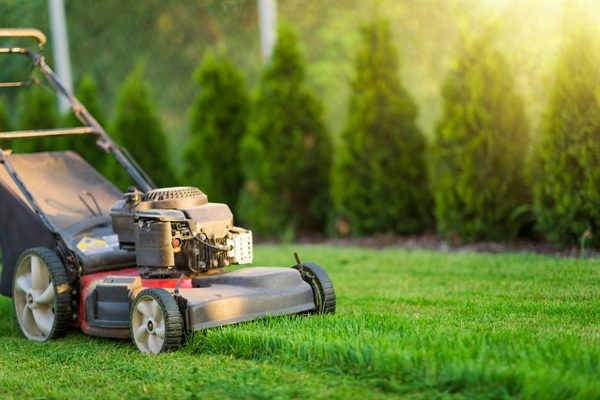Effective Lawn Care Tips for Summer Heat Stress Management

As summer temperatures soar, your lawn becomes a silent witness to the heat's intensity. Managing summer heat stress is crucial for maintaining a healthy, lush green lawn. Heat stress can make your grass vulnerable to disease, inhibit growth, and lead to unsightly browning.
Recognizing the signs and knowing how to counteract the effects of high temperatures can make a significant difference in the health of your turf. This blog will guide you through identifying heat stress, adjusting your lawn care practices during heatwaves, and implementing strategies to protect your lawn from the scorching sun.
We'll start by identifying the symptoms of heat stress, followed by practical adjustments to your watering and mowing routines. We'll explore effective fertilization techniques to fortify your lawn and conclude with innovative strategies to keep your lawn thriving throughout the summer season.
Identifying Signs of Heat Stress in Grass
Recognizing the early signs of heat stress in your lawn is the first step toward effective management. Symptoms include wilting, a bluish-gray tint, and footprints that remain on the grass long after being made. These signs indicate that your lawn's water reserves are depleted and the grass is unable to recover quickly. Prolonged exposure to high temperatures can lead to thinning turf and increased vulnerability to pests and diseases.
To accurately diagnose heat stress, observe your lawn during the hottest part of the day when symptoms are most visible. A soil moisture meter can be a useful tool in determining if your lawn is indeed suffering from a moisture deficit or if other factors might be affecting its health.
Understanding these signs helps in initiating timely interventions that can prevent further damage. This is crucial for maintaining a resilient and vibrant lawn throughout the harsh summer months.
Adjusting Watering Schedules During Heatwaves
During intense heatwaves, the usual watering schedule may not suffice to keep your lawn healthy. It's essential to adjust your watering strategy to provide deeper, less frequent watering. This encourages deeper root growth, which helps grass access water from deeper soil layers, enhancing drought tolerance. Watering early in the morning reduces evaporation and ensures that water reaches the roots where it's needed most.
Implementing a smart irrigation system can be a game-changer. Such systems adjust watering based on real-time weather conditions, ensuring that your lawn receives precisely the right amount of water at the right time, thus conserving water while optimizing lawn health.
Best Mowing Practices in Extreme Heat
Mowing your lawn during a heatwave requires careful consideration to avoid causing additional stress. Keeping the grass blades longer can shield the soil from sun exposure, reducing moisture loss and root exposure. Raise the mowing height of your lawn mower during extreme heat periods.
Avoid mowing during the heat of the day. Instead, opt for early morning or late evening when temperatures are cooler. This reduces the stress on your grass and prevents the sun from scorching freshly cut blades.
Sharp mower blades are essential; dull blades can tear the grass, leading to further stress and potential disease entry points. Ensuring your mower is in good condition is part of effective lawn management.
Preventing Heat Stress Through Proper Fertilization
Appropriate fertilization is critical in preparing your lawn to withstand and recover from heat stress. Applying a slow-release fertilizer that provides a steady supply of nutrients can help improve the resilience of your grass. Nitrogen, potassium, and phosphorus play vital roles in root development, water retention, and overall plant health.
However, it's important to fertilize at the right time. Fertilizing during cooler periods can prevent burns, which can occur if fertilizer is applied when temperatures are too high. A soil test can provide valuable information on the specific nutrient needs of your lawn, allowing for a tailored fertilization strategy.
Proper fertilization enhances the ability of your lawn to absorb water and nutrients, making it more robust against the stress caused by extreme heat.
Benefits of Shade Structures for Lawns
Installing shade structures is an effective way to protect your lawn from the harsh effects of direct sunlight during peak summer months. Shade structures such as pergolas, shade sails, or even strategically planted trees can provide much-needed relief to grass areas, reducing the temperature of the surface and the surrounding air.
Shade not only helps maintain moisture levels in the soil but also reduces the risk of sunburn on grass blades, preserving their photosynthesis capacity and overall health. Additionally, these structures can enhance the aesthetic appeal of your outdoor space, creating comfortable areas for relaxation and entertainment.
How Ben's Lawn and Landscape Can Help Your Lawn Thrive
At Ben's Lawn and Landscape, we understand the challenges that come with maintaining a healthy lawn through the scorching summer months. Our expertise in lawn care services enables us to provide tailored solutions that protect your lawn from heat stress and enhance its overall health and beauty.
From strategic watering schedules to advanced mowing techniques, our professionals equip you with the necessary tools and knowledge to keep your lawn green and lush. Our services include thorough assessments of your lawn's current condition, customized fertilization programs, and the installation of functional shade structures to mitigate the harsh effects of direct sunlight.
Ready to see how we can transform your lawn into a resilient landscape that withstands even the toughest summer heat? Contact us online or call us today at 763-258-9340 for a free estimate, and let's start making your lawn the envy of the neighborhood!